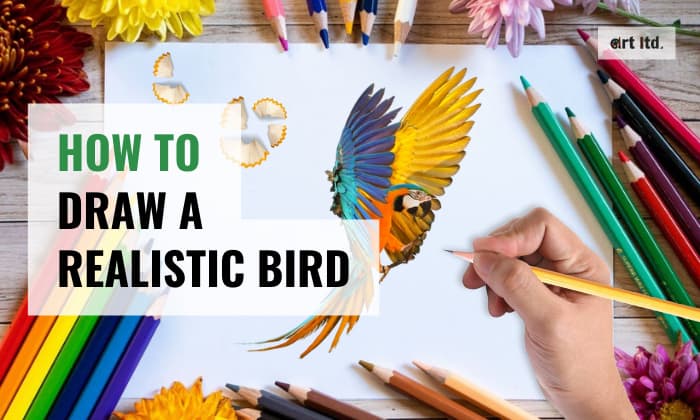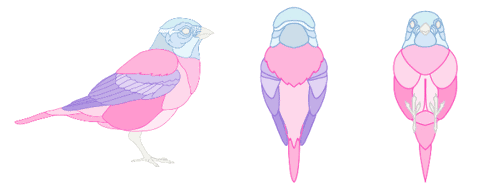Birds are fascinating, making them one of the favorite subjects for artists and beginners inclined toward realism. However, learning how to draw a realistic bird can sometimes be intimidating.
In this article, we will find out how to draw a bird step by step, understand its anatomy, and some sketching techniques.
In the later part, we will explore tips for drawing other bird species, how to add colors, and finally, the finishing touches.
Table of Contents
Understanding Bird Anatomy
Although there are about 10,000 types of birds across the globe, they more or less share the same anatomy. A bird’s body is covered with feathers. It has a pair of eyes, ears, legs, feet, wings, a beak, and 4 toes per foot—3 facing forward and 1 back.
These are fundamental parts of what you see on the surface, and having an understanding of each part can help you yield more realistic output.
There are also distinct features that you can highlight depending on what species you are targeting. These include the distinctive features of the head and around the eyes such as the:
- Lores – the area between the eyes and the beak
- Supercilium – also known as the eyebrows
- Eye Ring – the skin or feathers surrounding the eyes
- Crown – the hair on top of its head
Step-by-step on How to Draw Birds Easily and Realistically
1. Begin with having solid foundation lines.
- a. For this guide, we will draw a bird facing to the right.
Draw a line slanting at about 45 degrees to the right. This line will serve as the center of the body. Imagine that the two ends are where the head and the tail sit. For the body, draw an oval following your center line.
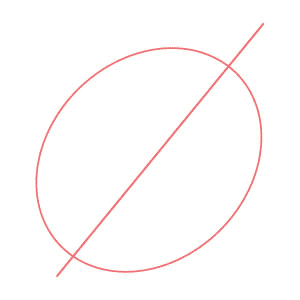
- b. For the head, sketch a small oval or circle so that it overlaps the body. How much the head and the body overlap will depend on how long the bird’s neck is. In most cases, one-third is a good start.
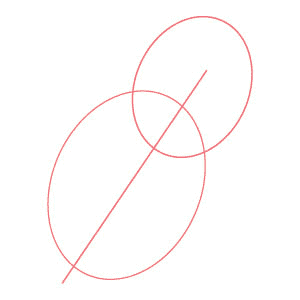
- c. Right below the top end of the line draw a short line across. This will serve as the beak. It should be slightly slanted following the direction of the head.
At the other end of the oval, draw another line that outlines the tail. It should be slanting down, starting from the part of the bigger oval right below the midline.

- d. At this point, we will start to shape it. Draw another line above the tail parallel to the initial outline; this time make a small curve before connecting it to the body.
Visualize the shape of the bird. Complete the undertail and neck by connecting the body to the tail and the head using shallow curves.
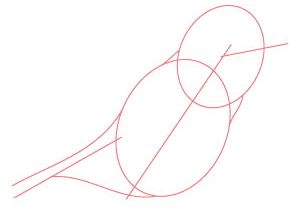
2. Complete the outlines for the tail, wings, legs, and beak.
- a. Draw a line with a similar angle to the tail starting from the lower center of the body and going to the ventral part.
Draw an acute triangle to outline the wings. The short side should span from the upper part down to the lower midline of the body.
For the legs and feet, draw two slanted perpendicular lines.
To form the beak, connect the curves towards the end of the beak construction line to make a triangle.

- b. Make a tiny circle for the eyes, it should sit at the cross-section connecting the beak construction line and the body centerline.
Draw a curve to connect the head and the wings.
The rest of the lines are pathway lines for the feathers that will help you in sketching up later.
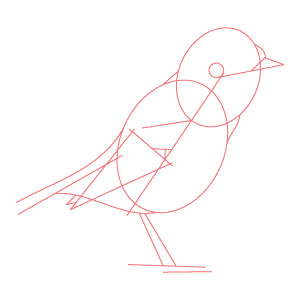
3. Start Sketching Up!
- Now that you have a complete outline you can now start sketching each part. Begin with redefining the head, beak, and eyes. Go back to the model and mimic these features.
- Work on the feathers, start with the big groups, these include the head, wings, and tails. The specifics of feather groups will vary depending on each species, so be sure to use a reference, such as a photo or an existing drawing of a bird to get the details right.
- Lastly, make the details of the legs and the claws.
Sketching Techniques
1. Freeze-Frame Technique
Commonly used in stage plays and filmmaking, this technique is especially helpful when sketching a living bird. Simply put, the method entails taking a mental picture of the bird and drawing it before the “picture” disappears.
To carry out this method, as soon as the bird strikes a pose, close your eyes and commit the image to memory. As you open your eyes, the image will float in your head momentarily. That’s the time to start sketching. Observe the bird as you go along and use the details you get from that.
2. Gesture Drawing Technique
Another way to draw birds in their natural habitat is by relying on gesture drawing—a technique that involves making quick and simplified sketches.
For this approach, you’ll need a soft graphite pencil to draw fluid lines. Try to draw with your whole arm for long but quick strokes. Don’t focus too much on the details – it’s the bird’s pose that you should pay attention to. Try to forgo erasing your mistake – just draw new lines directly on top of it.
3. Use Variations
To give your sketch more life, use different lines, textures, and shading. There are many techniques you can try.
Some of the basic techniques are hatching, scumbling, stippling, and blending. These are very useful when detailing the feathers and highlighting key features like the beak, eyes, and legs.
Drawing Different Bird Species
When drawing various types of birds, you have to go back to their anatomy. Before you start, you would want to see the particular features of that species so that you are aware of what to look at or what physical traits you need to highlight.
For example, eagles are known to have that fierce look in their eyes, large beaks, scaly feet, sharp claws, broad wings, and massive feathers.
Here are some tutorial videos that might inspire you before you get started:
- Explore drawing different bird’s eyes with colored pencils.
- The easiest way to draw different feet.
- Different birds and their beaks.
Adding Color to Your Bird Drawing
To make a bird drawing realistic, combine shading actions with linework. For instance, you can color the birds using pencils, then use a pen of the same hue to doodle small marks to accentuate the drawing.
Alternatively, pick various shades from the same color family to experiment with shading to give the impression that the birds have various layers of feather. It’ll also depict the bird’s interaction with lights and shadow, thus giving your drawing dimensions.
For beginners, you might want to start with two tones or plain black and white for a simple bird drawing.
Final Touches and Presentation
At this point, you have to take a step back and look at your model. See if you miss anything or if some parts or colors are not that cohesive. Erase unnecessary details.
Now that you are done with the main character, you can now add some background like the sky, flowers, leaves, tree, or anything that relates to the bird’s natural environment.
For example, if your subject involves a flock of birds flying then you can add a skyline or a complete view of a sunset.
Other Tips
- To draw a real bird, you have to emphasize the shape or how you do your outlines. All things will fall into place if you begin with a precise bird shape.
- Take note of the symmetry. Always refer to the centerline as you go further with the details.
- Know the feather groups. Be aware that the chest is composed of numerous feather groups that go in different directions and they can shift as the bird moves or change position.
- Before you draw, observe the bird closely. This is an easy way to learn its behavior, its features, and to look for the perfect angle.
Conclusion
Learning how to draw a realistic bird could be challenging but with a little patience and more practice, you will get a perfect sketch in no time.
Do not get discouraged if you do not get a perfect realistic bird right away. If ever you get confused, go back to the steps and break them into smaller steps, view existing sketchings of birds, watch more tutorials, and keep practicing instead.
Drawing realistic birds can be a fun activity for both kids and adults as long as you enjoy the process and do not forget to document your progress.

Art has always been a part of my life; it influences my upbringing and later my career choice. For me, it is always a part of my parenting technique. So for whichever purpose that you come to art, you can start here with us.
